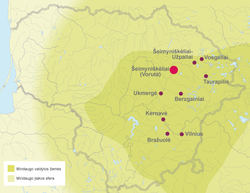- Duchy of Lithuania
-
Lietuvos kunigaikštystė (lt)
Duchy of LithuaniaDivision of the Grand Duchy of Lithuania 12th century–1413  →
→Domain of King Mindaugas (dark yellow) during the times of Kingdom of Lithuania, making up the initial Duchy of Lithuania. Capital Vilnius Government Monarchy Grand Duke of Lithuania - ca. 1236–1263 Mindaugas - 1295–1316 Vytenis - 1316–1341 Gediminas - 1345–1377 Algirdas - 1392–1413 Vytautas Historical era Middle Ages - Established 12th century - Union of Horodło 1413 Today part of Lithuania, Belarus, Latvia  Kernavė, the heartland of Lithuania in the 11th - 13th ct.
Kernavė, the heartland of Lithuania in the 11th - 13th ct.
Duchy of Lithuania (Latin: Ducatus Lithuaniae; Lithuanian: Lietuvos kunigaikštystė) was a state-territorial formation of ethnic Lithuanians, that existed from the 12th century[1] until 1413. Most of the time it was a constituent part and a nucleus of the Grand Duchy of Lithuania. Other alternative names of the territorial formation, used in different periods, were Aukštaitija or Land of Lithuania (11th – 13th centuries), Duchy of Vilnius (14th – early 15th centuries)[2], Lithuania Propria or simply Lithuania (in a narrow sense).
History
The formation emerged in the central and eastern part of the present-day Lithuania, known as Aukštaitija, as the Lietuva Land (Lithuanian: Lietuvos žemė). It is supposed to have formed in the central Lithuania on the left bank of the Neris River and swiftly expanded eastwards. This very land was mentioned in 1009 as Litua (see Name of Lithuania). The territory was ruled by senior dukes of an ethnic Lithuanian tribe, Aukštaitijans or "Lithuanians", in the initial meaning of the name.
After the expansion of the Lithuanian state in the 12th or 13th centuries, when it became known as the Grand Duchy of Lithuania and the Kingdom of Lithuania (1251–1263), the Duchy of Lithuania became an administrative unit, governed by dukes[3] and inherited by dynastic links. The main administrative center of the Duchy until the late 13th century might have been Kernavė.
It is plausible that the Duchy of Lithuania, that became known as the Duchy of Vilnius since the 14th century, was formed of the eastern part of the original Duchy of Lithuania under the rule of Grand Duke of Lithuania Vytenis at the end of the 13th century; its southwestern part was transformed to a separate Duchy of Trakai, under the dominion of Gediminas, who had established himself in the newly constructed Senieji Trakai Castle. It is known for certain that the Duchy of Trakai existed at the beginning of Kęstutis' rule in 1337 as his domain. It was a progenitor of the future Trakai Voivodeship.
The last Duke of Lithuania (Latin: Dux Lithuaniae) was Vytautas the Great, who received it in 1392 from Jogaila as a result of the Astrava Treaty, who in turn had inherited it from his father Algirdas. Since 1397, the Duchy had the status of an Eldership, comparable to that of the Eldership of Samogitia. After the administrative reform of 1413 by Vytautas, based on the Union of Horodło, the Duchy ceased to exist, becoming a part of the newly established Vilnius Voivodeship.
See also
References
- ^ C. Rowell, Lithuania Ascending: A Pagan Empire Within East-central Europe, 1295-1345
- ^ (Lithuanian) http://viduramziu.lietuvos.net/socium/provincijos.htm
- ^ Known as kunigas in Lithuanian, from German künig meaning "king"
Categories:- 1413 disestablishments
- History of Lithuania (1219–1569)
- Former subdivisions of Lithuania
- States and territories established in the 12th century
Wikimedia Foundation. 2010.


